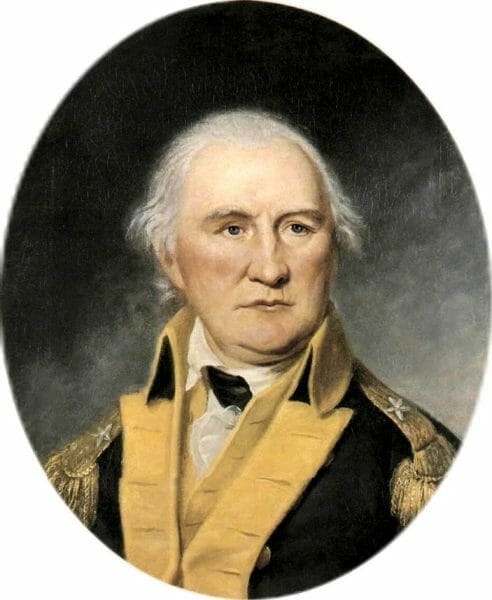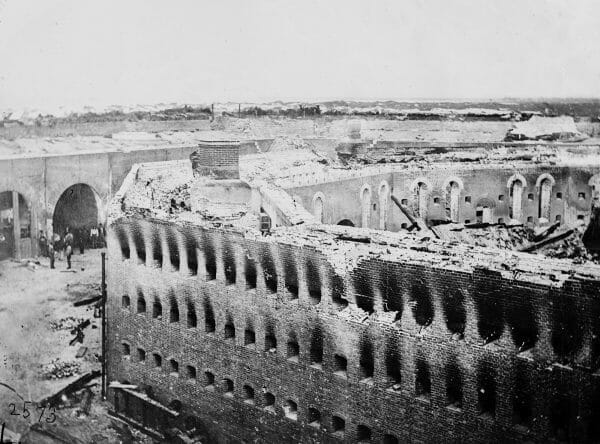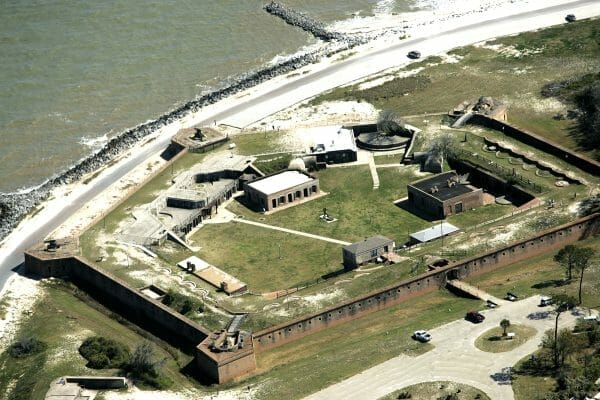Forts Morgan and Gaines
 Fort Morgan
Forts Morgan and Gaines, located on opposite sides of the Mobile Channel at the entrance to Mobile Bay, were built in the early years of Alabama‘s statehood by the federal government to protect the coastline. During the Civil War, however, neither installation halted federal naval and land forces, failing to protect Mobile Bay from U.S. Navy admiral David Farragut and his fleet. Later, during World War I and World War II, the forts again played a role in defending the coastline. Both structures are now preserved as historical sites.
Fort Morgan
Forts Morgan and Gaines, located on opposite sides of the Mobile Channel at the entrance to Mobile Bay, were built in the early years of Alabama‘s statehood by the federal government to protect the coastline. During the Civil War, however, neither installation halted federal naval and land forces, failing to protect Mobile Bay from U.S. Navy admiral David Farragut and his fleet. Later, during World War I and World War II, the forts again played a role in defending the coastline. Both structures are now preserved as historical sites.
Forts Morgan and Gaines were built as part of what was known as the Third System of fortifications, begun by the federal government in 1817 in the aftermath of its experiences in the War of 1812. It was during this period that fortification engineers built harbor defenses with a strategic defensive mission in mind. Each harbor fortification was well planned and sited to contribute to the defenses of other harbor defenses. The force behind the Third System was the federal Board of Engineers for Fortifications, which recommended two new forts in the vicinity of Mobile to replace Fort Bowyer on Mobile Point, Baldwin County, and Fort Charlotte, in Mobile, Mobile County. Military engineers designed the two forts to protect and defend Mobile Bay, the interior of Alabama, and the sea and land approaches to New Orleans via the Mississippi Sound and interior roads.
The introduction of rifled artillery and armored steamships during the Civil War, however, made masonry fortifications such as Morgan and Gaines obsolete, and Congress eventually ceased funding them. Conversely, increasing foreign and domestic advancements in artillery and naval technology prompted Pres. Grover Cleveland to form the Board on Fortifications and Other Defenses (also known as the Endicott Board) in 1885, which delivered a report on the nation’s coastal fortifications. The Board of Ordnance and Fortification was established in 1888 to continue laying the groundwork for the modernization of America’s harbor defenses in the late nineteenth century.
Fort Morgan
 Daniel Morgan
Fort Morgan was named after Revolutionary War hero Gen. Daniel Morgan and is located on Mobile Point, a peninsula at the mouth of Mobile Bay on the eastern side of the approach in Baldwin County. The site also housed the Mobile Point Lighthouse. Under the leadership of Gen. Simon Bernard, a former engineer with the French Army and a fortification expert, the U.S. Army Corps of Engineers designed the pentagonal (five-sided), five-bastioned fort in 1817 to guard the seaward approaches to Mobile Bay. The fort was constructed between 1819 and 1834.
Daniel Morgan
Fort Morgan was named after Revolutionary War hero Gen. Daniel Morgan and is located on Mobile Point, a peninsula at the mouth of Mobile Bay on the eastern side of the approach in Baldwin County. The site also housed the Mobile Point Lighthouse. Under the leadership of Gen. Simon Bernard, a former engineer with the French Army and a fortification expert, the U.S. Army Corps of Engineers designed the pentagonal (five-sided), five-bastioned fort in 1817 to guard the seaward approaches to Mobile Bay. The fort was constructed between 1819 and 1834.
After its completion, the U.S. Army briefly garrisoned Fort Morgan and used it as a staging area for Creek Indians who were being removed to Indian Territory in 1837. Afterward, Fort Morgan was only occasionally garrisoned and inspected. As Alabama politicians prepared to debate secession, the state militia seized Fort Morgan on January 5, 1861, and it remained under Confederate control until August 1864. After the Battle of Mobile Bay, federal land and naval forces subjected Fort Morgan to a siege of more than two weeks before its commanding officer surrendered on August 23, 1864. Although the Corps of Engineers had repaired the severely damaged structure by 1867, it and other harbor defenses languished in the years after the Civil War.
 Ruins of Fort Morgan Citadel
The Endicott Board recognized the importance of protecting Mobile Bay and recommended five modern gun batteries as well as naval mines for Fort Morgan. Constructed between 1895 and 1904, these batteries housed a total of 19 guns and mortars, all of which were the most modern weapons of the day. After the batteries were completed, Fort Morgan received no further upgrades; by the World War I era, guns on foreign battleships could easily outrange those of Fort Morgan and other U.S. harbor defenses. The fort was used as a training facility during the war, but the War Department declared Morgan obsolete in 1923 and sold it to the state of Alabama in 1927 for use as a state park. Activated briefly during World War II to counter the German U-boat threat in the Gulf of Mexico, the military returned the old fort to the state after the war, ending the era of harbor defenses at Mobile Bay.
Ruins of Fort Morgan Citadel
The Endicott Board recognized the importance of protecting Mobile Bay and recommended five modern gun batteries as well as naval mines for Fort Morgan. Constructed between 1895 and 1904, these batteries housed a total of 19 guns and mortars, all of which were the most modern weapons of the day. After the batteries were completed, Fort Morgan received no further upgrades; by the World War I era, guns on foreign battleships could easily outrange those of Fort Morgan and other U.S. harbor defenses. The fort was used as a training facility during the war, but the War Department declared Morgan obsolete in 1923 and sold it to the state of Alabama in 1927 for use as a state park. Activated briefly during World War II to counter the German U-boat threat in the Gulf of Mexico, the military returned the old fort to the state after the war, ending the era of harbor defenses at Mobile Bay.
Now operated by the Alabama Historical Commission, Fort Morgan, a National Historical Landmark, offers several annual events. School and group tours are available with prior scheduling and candlelight tours of the fort are held Tuesday nights during June and July. A morning and afternoon guided tour are also provided in June and July. Fort Morgan also offers living-history programs during April, July, and August. Fort Morgan’s museum has several Civil War-era historical document collections, numerous late-nineteenth and early-twentieth century documents pertaining the Fort Morgan’s role as a major coastal artillery base, and several early-twentieth century photograph collections relating to the fort. Twelve artillery pieces are also on display, ranging from the territorial period to World War I.
Fort Gaines
 Edmund P. Gaines
Fort Gaines was named after Gen. Edmund Pendleton Gaines, a hero of the War of 1812. The fort is located on the eastern tip of Dauphin Island, at the western approach to Mobile Bay. Originally designed in 1818 as the identical twin to Fort Morgan, work on the Dauphin Island fort was suspended in 1821 when Congress cancelled funding. Although Congress again authorized funding for the fort in 1846, construction did not begin until 1857. Army chief engineer Joseph Totten then scrapped the original 1819 plans and designed the pentagonal Fort Gaines using the latest French fortification theory of the 1850s to guard the seaward approaches to Mobile Bay and the eastern entrance of the Mississippi Sound.
Edmund P. Gaines
Fort Gaines was named after Gen. Edmund Pendleton Gaines, a hero of the War of 1812. The fort is located on the eastern tip of Dauphin Island, at the western approach to Mobile Bay. Originally designed in 1818 as the identical twin to Fort Morgan, work on the Dauphin Island fort was suspended in 1821 when Congress cancelled funding. Although Congress again authorized funding for the fort in 1846, construction did not begin until 1857. Army chief engineer Joseph Totten then scrapped the original 1819 plans and designed the pentagonal Fort Gaines using the latest French fortification theory of the 1850s to guard the seaward approaches to Mobile Bay and the eastern entrance of the Mississippi Sound.
Although construction on Fort Gaines was resumed in 1857, the fort was incomplete when Alabama state militia seized it on January 5, 1861, in anticipation of the state seceding from the United States, which it did January 11. Confederate engineers completed the fort over the next several years. It remained in Confederate hands until August 1864, when it fell in the same federal attack that brought down Fort Morgan. As with Fort Morgan, engineers quickly repaired Fort Gaines, but it also languished in the years after the Civil War.
 Fort Gaines
The Endicott Board recommended two modern gun batteries for Fort Gaines. Built between 1901 and 1904, these batteries housed six guns that complemented the modernizations at nearby Fort Morgan. With the exception of basic preservation, however, Fort Gaines received no additional improvements. As with Fort Morgan and other fortifications, its role in harbor defense waned as its guns were outmatched by those on foreign battleships. At the end of World War I, the War Department sold Fort Gaines to the state of Alabama. It was activated briefly during World War II and then returned to the state, which opened Fort Gaines as a state park in 1955.
Fort Gaines
The Endicott Board recommended two modern gun batteries for Fort Gaines. Built between 1901 and 1904, these batteries housed six guns that complemented the modernizations at nearby Fort Morgan. With the exception of basic preservation, however, Fort Gaines received no additional improvements. As with Fort Morgan and other fortifications, its role in harbor defense waned as its guns were outmatched by those on foreign battleships. At the end of World War I, the War Department sold Fort Gaines to the state of Alabama. It was activated briefly during World War II and then returned to the state, which opened Fort Gaines as a state park in 1955.
Fort Gaines is currently under the management of the Dauphin Island Park and Beach Board and events are scheduled throughout the year. The Battle of Mobile Commemorative Day is held in August, followed by “Colonial Isle Dauphine” in October, and “Christmas at the Fort” in December. Fort Gaines’s museum contains Civil War-era historical documents and photographs of the fort’s role as a coastal artillery post. Fort Gaines also retains on display eight original artillery pieces from the fort’s Civil War days.
Further Reading
- Berhow, Mark A., ed. American Seacoast Defenses, A Reference Guide. Bel Air, Md.: Coast Defense Study Group Press, 1999.
- Clary, David A. Fortress America: The Corps of Engineers, Hampton Roads, and United States Coastal Defense. Charlottesville: University of Virginia Press, 1990.
- Hearn, Chester G. Mobile Bay and the Mobile Campaign: The Last Great Battles of the Civil War. Jefferson, N.C.: McFarland, 1993.



